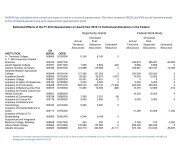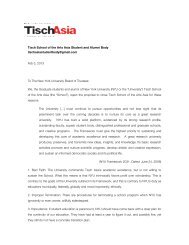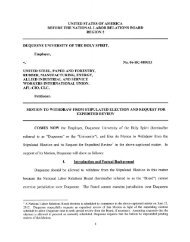survey of admissions directors - Inside Higher Ed
survey of admissions directors - Inside Higher Ed
survey of admissions directors - Inside Higher Ed
Create successful ePaper yourself
Turn your PDF publications into a flip-book with our unique Google optimized e-Paper software.
Table 13Are “Traditional Students” Enrolling in Community Colleges?PercentagesA decline in the number <strong>of</strong> traditional students at my campus since 2008 2.6No real change in the numbers <strong>of</strong> traditional students enrolled at my campus in the past three years 15.4A slight increase (under 5 percent) in the numbers <strong>of</strong> traditional students 29.9A modest increase (5-15 percent) in the numbers <strong>of</strong> traditional students 37.6A major increase (16-25 percent) increase in the numbers <strong>of</strong> traditional students 12.0A dramatic increase (over 25 percent) in the numbers <strong>of</strong> traditional students 2.6Table 14How Would You Describe the Competition for Students with For-Pr<strong>of</strong>it CollegesNow Compared to Fall 2008?PercentagesNot really an issue for my institution; little competition from for-pr<strong>of</strong>its 36.4Some additional competition compared to fall 2008, but nothing we cannot handle 34.8Significant competition for students in selected programs (e.g., health care, information systems) 22.0Significant competition for students across all fields and programs 6.8Even as community college enrollmentsare rising, more than three-fifths(63.6 percent) <strong>of</strong> community college<strong>admissions</strong> <strong>directors</strong> acknowledge increasedcompetition from for-pr<strong>of</strong>it institutions.However, as shown in Table 14,less than a third (28.6 percent) view forpr<strong>of</strong>itcolleges as significant competitionfor students, while more than a third (34.8percent) report that the additional competitionis “nothing we cannot handle.”Online education has been an importantfactor in the enrollment gains postedby many community colleges since2008. <strong>Inside</strong> <strong>Higher</strong> <strong>Ed</strong>’s 2011 PresidentialPerspectives report, released earlierthis year, revealed that a large majority<strong>of</strong> community college presidents, liketheir peers in other sectors, saw onlineeducation as a way to serve more learners(89.4 percent) and also increase nettuition revenue (76.5 percent).A third (33.9 percent) <strong>of</strong> communitycollege <strong>admissions</strong> <strong>directors</strong> report thatonline programs (full programs leadingto a degree or certificate that can be completedonline) are a “rising and increasinglyimportant component” <strong>of</strong> total institutionalenrollment; another fourth (25.2percent) categorize online programs asa “small but generally rising component<strong>of</strong> our enrollment.” In contrast, two-fifths(40.9 percent) report that enrollments inonline programs are either not significant(13.9 percent) or that their institutions <strong>of</strong>ferindividual online courses but not completeonline programs.The fourth <strong>survey</strong> item unique tocommunity colleges addresses competitive<strong>admissions</strong> within individualcertificate and degree programs. Althoughcommunity colleges are typicallyopen-admission institutions, the<strong>survey</strong> respondents representing twoyearpublic institutions acknowledgethat admission into specific programs attheir institutions may be competitive orselective. For example, more than tw<strong>of</strong>ifthsreport that students must “achievecertain grades in prerequisite courses”to gain admission into some programs.More than a fifth (22.2 percent) reportthat some programs admit more than afourth but less than half <strong>of</strong> applicants,while 20 percent state that some programsat their institutions admit lessthan a fourth <strong>of</strong> all applicants.The Pr<strong>of</strong>ile <strong>of</strong> Survey ParticipantsThe <strong>survey</strong> data warrant a short comment about the demographic pr<strong>of</strong>ile <strong>of</strong> the <strong>survey</strong> participantsacross sectors. The median age and average number <strong>of</strong> years as the chief <strong>admissions</strong> directorwere identical in four-year and two-year institutions. However three-fifths (59.9 percent) <strong>of</strong> the senior<strong>admissions</strong> or enrollment management <strong>of</strong>ficers in four-year colleges and universities were male;in contrast, two-thirds (67.8 percent) <strong>of</strong> the community college <strong>survey</strong> participants were female.2011 SURVEY OF COLLEGE AND UNIVERSITY ADMISSIONS DIRECTORS INSIDE HIGHER ED15






